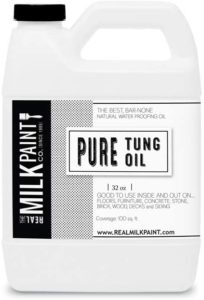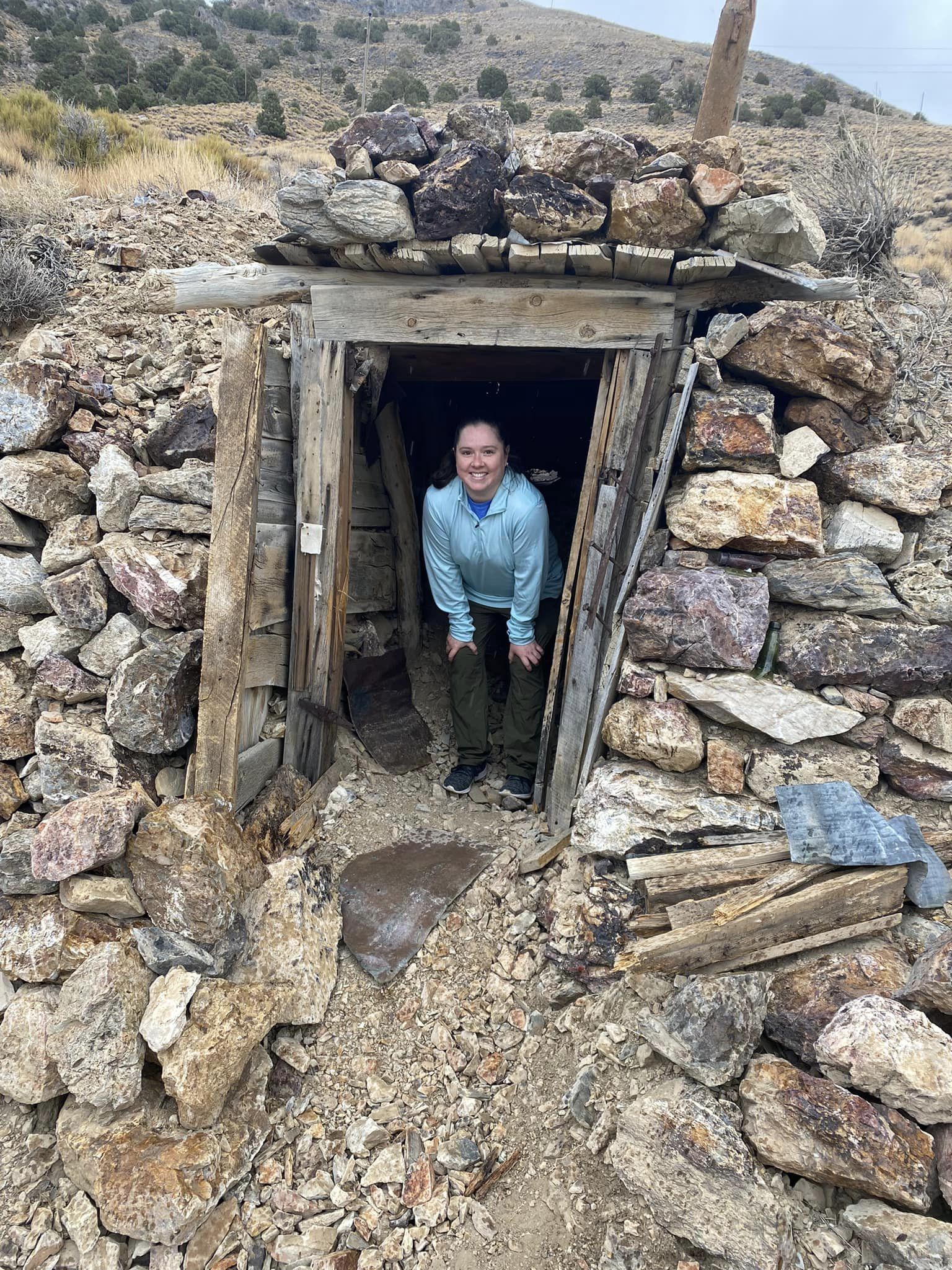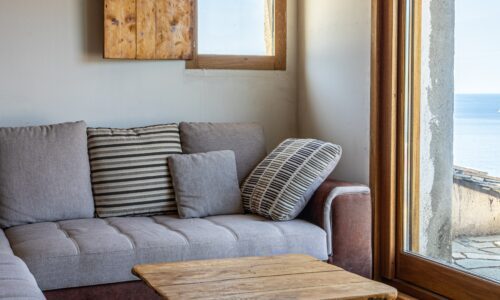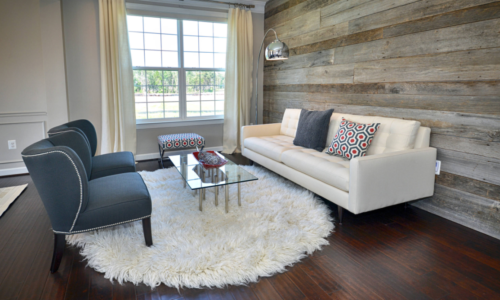A Complete Guide to Food Safe
Wood Stain and Sealers
During my time as a paint department manager, I had many customers ask me what type of food safe wood stain and sealer would best for things like butcher blocks, cutting boards, salad bowls, wooden utensils etc. According to George Snyder, a Product Manager with Woodcraft, “all finishes made after 1972 are food-safe when cured properly. This process can take several weeks after a film has formed”. It’s extremely important to read all labels, and follow the instructions!
Additionally, avoid oils that can spoil like vegetable oil or olive oil. These oils have a shelf life, and have an off-putting taste when used.
The products I’ve listed below are recommended by woodworkers, finishing experts and manufactures and chemists. It’s important to note that these finishes are typically provide only a minimal amount of protection. You’ll have to frequently re-apply these products to keep your wood sealed and protected.
Pure raw linseed oil is NOT the same as boiled linseed oil. Linseed oil is obtained from the dried, ripened seed of the flax plant. It is an edible oil and can be used as a nutritional supplement as a source of omega-3 fatty acids (I’m not saying you should use this as a dietary supplement). Raw linseed oil is water-repellent and dries to a semi-gloss finish.
The Walrus Oil brand has become a favorite amongst woodworkers that make things that come in contact with food. It’s made from coconut oil, beeswax, mineral oil and Vitamin E. Wood wax provides extra protection from water and moisture. The application process is incredibly simple. Just use a soft cloth to apply a thin layer of wax. Let it sit for 15 minutes and then buff it with a rag. It can be used as a standalone product, or it can be applied after applying a layer of “Cutting Board Oil”.
Pure beeswax can be used for so many different purposes because it’s natural and cost efficient! It’s a popular choice for maintaining and protecting wood surfaces that come in contact with food. Beeswax will hydrate wood, and make it shine. It is also water repellent. You can use a wood conditioner specifically formulated with beeswax, like the one by Howard’s below, or you can melt the beeswax with mineral oil and create your own. Use 1 part beeswax to 2 parts mineral oil.
Walnut oil is derived from English walnuts… who would’ve thought! Ha! Walnut oil will provide a non-toxic finish that repels water and alcohol. It will not give any aftertaste to food like some other finishes. However, walnut oil should be used with caution because it is made from a tree nut. Nut allergies are quite common.
Walnut oil can be applied a brush, cloth, or steel wool. You’ll need to allow the oil to soak in for at least 30 minutes before you wipe off the excess and you should wait 24 hours before applying another coat. Three or four coats should be sufficient.
Shellac is a food safe wood stain made from a resin secreted from the female lac bug and ethanol. It is available in a clear or amber tint. Shellac brings out the rich warmth of wood grain making surfaces look soft and natural instead of plastic. As long as shellac does doesn’t come in contact with chemicals, water or heat, the finish will last many years.
Tung oil is a base used in various other blended sealers. It will dry to a slight golden, satin tint. It’s important to use caution with tung oil because it is made from the tung tree which produces nuts. Nut allergies are quite common.
You’ll want to look for 100% pure tung oil. This finish will repel food particles, liquids and oils. Using tung oil will provide a protective waterproof finish and it doesn’t mold, darken, and it dries faster than other oils. The finish may be maintained by re-applying tung oil as needed.
Howard’s butcher block oil and conditioner are environmentally biodegradable organic waxes. Mineral oil is colorless, odorless and tasteless. Mineral Oil will prevent un-finished wood from cracking and/or drying out. Did you know that drug stores even sell mineral oil as a laxative? Make sure to read the product label and find where it says “food-safe” because some mineral oil is not safe for consumption; often used as lubricant for machinery.
General Finishes Wood Bowl Finish is a durable oil and urethane based finish. It dries to an amber color with a gloss finish. It is for interior use only and requires 3 coats for maximum durability. You can apply to raw wood, or you can apply it over an existing finish. The coating can be applied with a brush, roller, or sprayer. It will be dry to the touch in 12 hours, but should not be re-coated for at least 24 hours. It takes 30 days to fully cure, but you can begin light use within 7-10 days.
*Wood Bowl Finish is what I would consider to be a last resort. If you already have this at home, and need to seal something that food will be on, use it. However, I’d really recommend any of the other options above before using Wood Bowl Finish for food surfaces.
*Note: Walnut wood only needs 2 coats as it’s naturally oily wood.
As you can see, there are many food safe wood stain and sealer options. If you’d like information on other top-coats and sealers, click here.
I hope this post has helped you decide which food safe wood stain and sealer would be best for your situation. Make sure to follow me on Pinterest, Facebook and Twitter for all of the latest! Also feel free to leave questions or comments below! I love hearing from you!

















17 Responses
What if I want to stain a Beech butcher block a dark walnut, but also make it safe?
Hey Toby! I definitely would NOT use a stain on the beech butcher block. Wood stain is not typically food safe. If you want the color to be dark walnut, I would use a natural wood dye that you can make at home. There are a lot of recipes you can find online, but I’d recommend using coffee. I don’t have a post or recipe on natural wood dyes yet, but here’s a link to a recipe that I’ve used before. Once you’re happy with the color, you can use any of the food-safe sealants listed on my post. I hope that helps! https://www.instructables.com/id/How-to-Dye-Wood-Using-Natural-Ingredients-in-5-Ste/
I would like a food safe sealer for painted wood
ie: painted salad bowls and cheese boards
You can use General Finishes ‘Wood Bowl Finish’ unless you’re going to be chopping and cutting on a consistent basis. If so, I’d use Butcher Block Oil, even though you were specifically referring to salad bowls and cheese boards.
Can you use any water-based paint on a cutting board and then put any sealant on top to make it food safe? I’m confused because you said “wood stain is not typically food safe.” If you put a sealant, such as shellac over the wood stain, would it be just as safe as using as sealant over painted wood as you mentioned? Thank for your guidance.
That is a really great question! Any sealant is non-toxic once it has cured. So to answer your question, yes, if you put sealant like shellac over wood stain, it will be safe once it has cured. Make sure to read the directions to know exactly how long it will take to cure.
Looking to seal a butcher block cart to use outside by the grill for serving. Wont be putting food directly on it. Will use the ‘cart’ top for serving platters. The top was previously been sealed w linseed oil and used in a kitchen.
Thanks in advance for your help.
Hi, your article is very helpful. My question is my cutting board (jhon boos) have some crack how and what kind of wood filler that is safe that i can use?
Thanks and more power!
Paul
Hi Paul! I would actually recommend using food-safe wood glue. Titebond III Ultimate Wood Glue (green bottle) is FDA-approved for use on food preparation surfaces and easy to clean up since it’s water-soluble when wet. Use a syringe to inject the glue into the crack. It’s okay if it overfills the crack. Just use extra fine-grit sandpaper to sand it down once the glue has dried (usually 24 hours) and then re-seal it with any of the options listed on this post.
Thank you so much for such an informative piece of information 🙂
If anyone interested similar one’s have a look here
Besttoolsbrand
Thanks
I have a cutting board that I used my Minwax oil based stain on. What can I seal it with to make it food safe?
I would use General Finishes Salad Bowl Finish. I’m hesitant to recommend anything else because I don’t know how it would react with the oil based stain you used. That’s why I think General Finishes Salad Bowl Finish is the safest option.
What would you use for a cutting board that has been stained and top coated with water based behr
I want to put a butcher block Island in my kitchen. It will be a rental. What can I use that is food safe if I can only re-apply maybe 3-4 times a year? thanks
Hi, Anthony! Beeswax would be a good option! It’s food-safe, and can be applied multiple times a year.
So none of the above are stains, they are finishes.
Hi, Paul! While a majority of the products listed here or “sealers” or “finishes”, some of them have a pigment like shellac and will stain the surface in addition to sealing it.